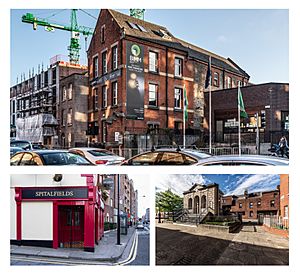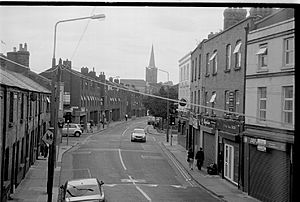The Coombe, Dublin facts for kids
| An Com (Irish) | |

Clockwise from top: Coombe campus of the British and Irish Modern Music Institute; the Coombe Hospital Memorial; Spitalfields pub
|
|
| Namesake | Named after the Coombe Stream (from Irish com, "coom", valley) |
|---|---|
| Length | 450 m (1,480 ft) |
| Width | 15 metres (49 ft) |
| Location | Dublin, Ireland |
| Postal code | D08 |
| west end | Pimlico, Ardee Street |
| east end | Francis Street, Dean Street |
| Other | |
| Known for | Coombe Women & Infants University Hospital |
The Coombe (pronounced 'koom') is a very old street in the south part of Dublin, Ireland. Its name comes from an old Irish word meaning "valley" or "hollow." This is because a small stream, called the Coombe Stream or Commons Water, used to flow through this area. This stream was a branch of the River Poddle. Sometimes, "The Coombe" refers to the wider area around the street, where these streams were very important.
Contents
The Coombe's Rich History
The Coombe area started to grow in the late 1600s. Many people who made clothes and fabrics moved here. English settlers began making woolen goods. At the same time, many French settlers, known as Huguenots, came to Dublin. They were skilled in weaving silk and brought their talents with them.
The Dutch also built their special houses here. These houses had gables (the triangular part of a wall at the end of a pitched roof) facing the street. They were called "Dutch Billies." Soon, thousands of weavers worked in areas like The Coombe, Pimlico, Spitalfields, and Weavers' Square.
Changes in Trade and Industry
In 1782, the Irish Parliament, known as Grattan's Parliament, made new laws. These laws allowed for more free trade. Before this, England had made rules to protect its own wool industry. They put high taxes on Irish wool exports. The Navigation Act even stopped Ireland from selling goods to many colonies.
In 1699, the English government passed the Wool Act. This law stopped Ireland from selling wool to any country. This rule almost ended the wool industry in the Liberties area of Dublin by the mid-1700s.
Later, the laws changed again, and the industry started to recover. People began importing wool from Spain. The Royal Dublin Society helped this revival from 1775. However, big events like the rebellions of 1798 and 1803, where many weavers took part, caused problems. Also, the economy got worse after the Napoleonic Wars and the Act of Union. These events stopped the fabric industry from growing further in the Liberties.
Weavers' Hall and Support
The Weavers' Guild built a special meeting place called the Weavers' Hall in the Lower Coombe in 1682. By 1745, they needed a new hall. A Huguenot named David Digges La Touche gave them the money to build it.
The silk and poplin (a type of fabric) industries did very well in the early 1700s. The Royal Dublin Society supported these industries. But then, the English government passed a law that stopped the society from helping any place that sold Irish silk. This hurt the industry. When war started against France, it became hard to get raw materials. This made things even tougher for the silk weavers.
The Tenter House
In 1815, a building called the Tenter House was built near The Coombe, on Cork Street. A man named Thomas Pleasants paid for it. Before this, poor weavers in The Coombe had a hard time. They had to stop working when it rained because they couldn't dry their cloth. Sometimes, they even had to use fires in pubs to dry their work. This often led to them being in great trouble, sometimes ending up in hospitals or even jail. The Tenter House helped them dry their cloth properly.
Local Churches and Community
In 1708, a new church area, or parish, was created for the Church of Ireland. It was called St. Luke's. A house for the local priest was built on The Coombe. The church of St. Luke was also built nearby. Over the next few years, more buildings were added along The Coombe. These included a school, a place for the poor (an almshouse), and a house for widows. These buildings helped the growing number of people living in the area.
Coombe Hospital: A Place of Care
On October 10, 1770, a new hospital called the Meath Hospital began construction in The Coombe. In 1774, it became the main hospital for County Dublin. Later, in 1822, the patients moved to a new Meath Hospital building.
A few years after that, a woman named Mrs. Margaret Boyle started the Coombe Lying-In Hospital in the old building. This hospital focused on helping women giving birth and caring for babies. The famous Guinness family, who made beer, became big supporters of the hospital. They even built a special building for giving out medicine. In 1967, the hospital moved to a new location on Cork Street. The old building was taken down to make way for new homes, but its front entrance was saved.
The Aldermen of Skinners Alley
Near The Coombe, there used to be a small street called Skinners Alley. This alley was famous for a group called the 'Aldermen of Skinners Alley'. When King James II removed the Protestant leaders of Dublin to replace them with Catholics, some of the original leaders hid themselves and the city's important symbols in this quiet alley.
After a big battle called the Battle of the Boyne, they came out of hiding. They showed themselves to King William, who then accepted them as the true leaders of Dublin. Every year, on the day they were put back in charge, these leaders would celebrate with a big dinner. Over time, a friendly club was formed, and they called themselves 'The Aldermen of Skinners Alley'.
They even had a song about their history:
When tyranny's detested power
had leagued with superstition,
and bigot James, in evil hour
began his luckless mission,
still here survives the sacred flame,
here freedom's sons did rally
and consecrate to deathless fame
the Men of Skinners Alley.


